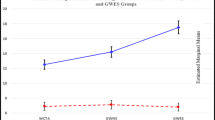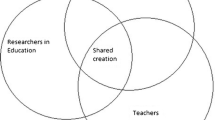Abstract
In the US, there is a significant number of learning-disabled high school students included in regular science classrooms. It has been argued that students with learning disabilities can succeed in science if they receive the kind of instruction they need. To facilitate such instruction, the special education teacher is often incorporated into the class along with the learning disabled students. We observed 53 high school science lessons from ten pairs of science and special-education teachers who were responsible for delivering instruction to groups of students, some of whom were learning-disabled. We analyzed narrative notes collected in these lessons reflecting the kinds of classroom activities, organization of work, and teachers’ roles. In addition, we interviewed the teachers individually to gain a better understanding of these inclusive classes. The underlying question of this research was whether inclusive classes with two teachers delivered the type of science education that is better than solo-teaching in addressing the needs of learning-disabled students. Our evidence indicates that even with a special-education teacher present in the class, learning-disabled students usually did not receive a science education that met their needs. We elaborate on the reasons for this problem and make suggestions for improvement.
Similar content being viewed by others
References
Atwood, R.K. & Oldham, B.R. (1985). Teachers’ perceptions of mainstreaming in an inquiry-oriented elementary science program. Science Education, 69, 619–624.
Baum, S.M., Cooper, C.R. & Neu, T.W. (2001). Dual differentiation: An approach for meeting the curricular needs of gifted students with learning disabilities. Psychology in the Schools, 38, 477–490.
Brownell, M.T. & Thomas, C.W. (1998). An interview with.... Margo Mastropieri: Quality science instruction for students with disabilities. Intervention in School and Clinic, 34, 118–122.
California State Board of Education (2004). Retrieved on 1/26/2007, from <http://www.aeoe.org/news/online/sci_standards/hands-on_update.html>
Cawley, J., Hayden, S., Cade, E. & Baker-Kroczynski, S. (2002). Including students with disabilities into the general education science classroom. Exceptional Children, 68, 423–435.
Chung, S. (1998). The compatibility of reform initiatives in inclusion and science education: Perceptions of science teachers. Unpublished doctoral dissertation, Purdue University, West Lafayette, IN.
Cook, L. & Friend, M. (1995). Co-Teaching: Guidelines for creating effective practices. Focus on Exceptional Children, 28(3), 1–16.
Cross, L. & Walker-Knight, D. (1997). Inclusion: Developing collaborative and cooperative school communities. The Educational Forum, 61, 269–277.
Curriculum Review (2004). Don’t experiment with science lab safety: An interview with Jack Gerlovich. Curriculum Review, 43(6), 14–15.
Dieker, L.A. (2001). What are the characteristics of the “effective” middle and high school co-taught teams for students with disabilities? Preventing School Failure, 46(1), 14–23.
Echinger, J. (1997). Successful students’ perceptions of secondary school science. School Science and Mathematics, 97, 122–132.
Friedler, Y. & Tamir, P. (1990). Sex differences in science education in Israel: An analysis of 15 years of research. Research in Science and Technological Education, 8, 21–34.
Keefe, E.B., Moore, V. & Duff, F. (2004). The Four “Knows” of collaborative teaching. Teaching Exceptional Children, 36(5), 36–42.
Linn, M.C. & Burbules, N.C. (1993). Construction of knowledge and group learning. In K. Tobin (Ed.), The practice of constructivism in science education (pp. 91–119. )Washington, DC: American Association for the Advancement of Science.
Long, S. (2006). The science teacher: Spring 2006. Journal of Chemical Education, 83, 830–832.
Morocco, C.C. & Aguilar, C.M. (2002). Coteaching for content understanding: A school-wide model. Journal of Educational and Psychological Consultation, 13, 315–347.
National Science Teachers Association position statement (2007). The integral role of laboratory investigations in science instruction. Retrieved on 12/18/07, from <http://www.nsta.org/about/positions/laboratory.aspx>
Neu, T.W., Baum, S.M. & Cooper, C.R. (2004). Talent development in science: A unique tale of one student’s journey. The Journal of Secondary Gifted Education, 26, 30–36.
Norman, K., Caseau, D. & Stefanich, G.P. (1998). Teaching students with disabilities in inclusive science classrooms: Survey results. Science Education, 82, 127–146.
Parmar, R., DeLuca, C. & Janczak, T. (1994). Investigations into the relationship between science and language abilities. Remedial and Special Education, 15, 117–126.
Quinn, P. (1996). NELS:88 High School Seniors’ Instructional Experiences in Science and Mathematics. Retrieved on 6/12/06, from <http://nces.ed.gov/pubsearch/pubsinfo.asp?pubid = 95278>
Roth, W.-M., Tobin, K., Carambo, C. & Dalland, C. (2005). Coordination in coteaching: Producing alignment in real time. Science Education, 89, 675–702.
Scruggs, T.E. & Mastropieri, M.A. (1994a). Successful mainstreaming in elementary science classes: A qualitative investigation of three reputational cases. American Educational Research Journal, 31, 785–811.
Scruggs, T.E. & Mastropieri, M.A. (1994b). The construction of scientific knowledge by students with mild disabilities. Journal of Special Education, 28, 307–321.
Scruggs, T.E., Mastropieri, M.A. & Boon, R. (1998). Science education for students with disabilities: A review of recent research. Studies in Science Education, 32, 21–44.
Singer, S.R., Hilton, M.L. & Schweingruber, H.A. (2005). America’s lab report: Investigations in High School Science. Washington DC: The National Academies Press.
Staub, D., & Peck, C.A. (1995). What are the outcomes for nondisabled students? Educational Leadership, 36–40.
Sterling, D.R. & Goor, M. (1998). Science for your students? Intervention in School & Clinic, 34, 123–126.
Stohr-Hunt, P.M. (1996). An analysis of frequency of hands-on experiences and science achievement. Journal of Research in Science Teaching, 33, 101–109.
Tobin, K. & Roth, W.-M. (2005). Implementing coteaching and cogenerative dialoguing in urban science education. School Science & Mathematics, 105, 313–322.
U.S. Department of Education (2006), Office of Special Education Programs, Individuals with Disabilities Education Act. Retrieved on 12-26-07, from < https://www.ideadata.org/arc_toc8.asp#partbCC >
Author information
Authors and Affiliations
Corresponding author
Additional information
This research was supported by a Field Initiated Research grant (#H324C000035) from the US Department of Education, Office of Special Education Programs. We wish to thank Connie Emmerling, Debbie Lawler, David W. Matta, and Jane Partanen for their contributions to the collection of the data and reviews of early versions of the manuscript. We also wish to thank all the teachers who volunteered to be observed for this study.
Earlier versions of this paper were presented at the National Association for Research in Science Teaching meeting, April 1–4, 2004, Vancouver, BC, and at the 2007 Annual Meeting of the Association for Science Teacher Education, Clearwater, FL. Earlier versions appear in the respective proceedings.
Rights and permissions
About this article
Cite this article
Moin, L.J., Magiera, K. & Zigmond, N. INSTRUCTIONAL ACTIVITIES AND GROUP WORK IN THE US INCLUSIVE HIGH SCHOOL CO-TAUGHT SCIENCE CLASS. Int J of Sci and Math Educ 7, 677–697 (2009). https://doi.org/10.1007/s10763-008-9133-z
Received:
Accepted:
Published:
Issue Date:
DOI: https://doi.org/10.1007/s10763-008-9133-z




